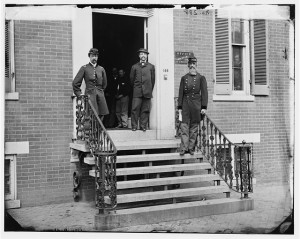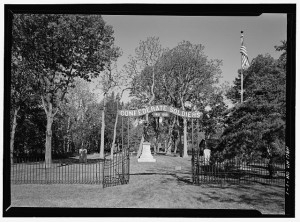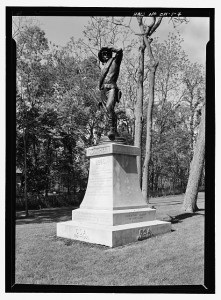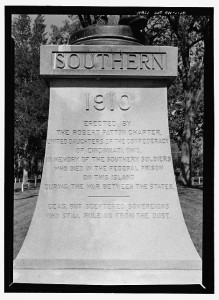From The New-York Times January 14, 1862:
THE NEW DEPOT FOR PRISONERS OF WAR.
The depot erecting by the Government on Lake Erie for the reception of prisoners of war, is thus described by a Sandusky correspondent of the Cleveland Herald:
“Yesterday morning I made a water excursion over to Bull’s Island, to see the buildings now in process of erection for the prisoners’ depot, and having a thought with reference to its sanitary position, I give you the results of my observations.
Bull’s Island lies within Sandusky Bay, about a mile from its mouth, and about two miles from Sandusky, (Ohio) with easy access by a ferry. It contains about three hundred acres, with a prominent limestone ridge in the centre, with a gentle descent in each direction to the water edge, and with no marsh or swampy ground within its borders. Sixty acres have been leased by the Government for the purpose of a prisoners’ depot, in which to place the captured rebels for safe keeping, and which will be ready for their occupation by the first of February next, and which will be guarded by two companies of soldiers. The buildings now erected comprise a storehouse, three houses for officers’ quarters, a soldiers’ barracks — each are large and roomy — a hospital building, in dimensions 100 feet long by 24 feet wide; a long one-story house, in the rear of the others and somewhat relived, and immediately under the limestone bluff, sheltering it from the northerly and westerly winds, with doors and windows opposite each other, affording free draft and ventilation — a nice and comfortable tenement for those poor customers consigned to the [t]ender mercies of the doctors and surgeons.
Further to the east of these buildings is the inclosure for the prisoners, of some fifteen acres, a stout plank-board fence, eight feet high, with sentry boxes and sentry walks; within are eight large two-story structures, substantially built, airy and spacious, and contrast favorably with the narrow, crowded, unhealthy jail accommodations of the South, into which our prisoners are cast. There is ample room for the erection of other buildings to any extent, if the numbers of the prisoners should demand. Large room is allowed within the inclosure for exercise and games upon a fine plateau of ground — which, by-the-by, should have a few blind drains constructed to carry off the more readily superfluous moisture, and render the whole the more dry.
The position of the depot is a fortunate selection, and does credit to the judgment of Col. HOFFMAN. It is safe, from its isolated island position, easily supplied with all the necessities of subsistence, with an easterly and southern exposure, having the grateful, health-bearing winds of Lake Erie full in their front, an abundance of soft lake water — a matter of much importance in a sanitary point of view — and altogether a charming spot.
Much yet remains to be done, as but the outside of most of the inclosures are finished. Eighty mechanics, however, make rapid progress. As yet nothing is done in the construction of out-houses, ice-cellars, wells, cisterns, drains, &c., of which all will come around in due time.”
You can read a good overview (with photos) of the POW Depot on Johnson’s Island at this site. There is a bit of mystery/discrepancy about William Hoffman, who was the Commissary-General of Prisoners during the Civil War. The sources used at Wikipedia say he was a prisoner from February 1861 until August 1862. The Times article and the Johnson’s Island site I just linked to make it seem he was out before that.
Civil War Bookmarks has a post quoting Henry Kyd Douglas from his I Rode With Stonewall describing the freezing winter conditions at the Johnson’s Island prison depot. It got down to 28 below at one time.





